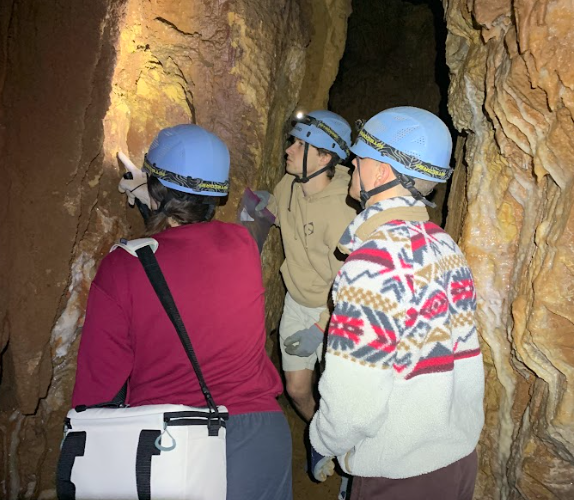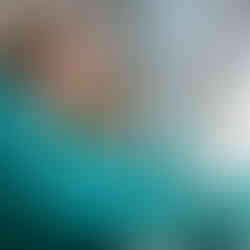REU 2025!
- caesarlk
- Aug 22
- 5 min read
Another fantastic summer in the books! As much as I am learning to love classroom teaching, the full time research with inspired undergraduate students is still my absolute favorite part!
This year we had a big group, featuring two Caesar lab veterans, Frances and Carly, and two new folks, Max (our guest star from the Hughey lab) and Landon! We continued evaluating the impacts of growth conditions on bacterial metabolism, assessed the heavy metal tolerance of cave-derived fungi, collected (too many) samples from Grand Caverns to expand our microbial culture collection, and participated in a fun outreach program at the Farmer's Market! And of course, the final symposium was a blast. So proud of everyone! It was, as usual, so great getting to know everyone more personally this summer.

Before I get into the nitty gritty research details, I'll share some fun attention-grabbing photos of our annual Grand Caverns microbial collection trip! This was our biggest group yet, featuring all of our summer students, plus two bonus participants, Caesar lab alum Shyleigh, and MacDonald lab alum, Miranda! We've now collected swabs, cave water, and/or soil samples from all across the "main" cave, which has been accessed nearly daily for over 200 years! We collected entirely too many samples (it's just so fun), from a variety of cave locations including the Temperature Room, the Shield Room, the Zoo, and Sir Walter Scott's Room. Once we've isolated the strains, we will extract DNA to identify the culturable microbes that live throughout the cave, and evaluate impacts of sample type, human activity, and location on taxonomy! We also plan to assess their biotechnological promise (more on that in a bit...)

Click through the galley to see more fun photos from our collection trip! Thanks Shyleigh for being our photographer!
Carly's project is taking advantage of our amazing culture collection from Grand Caverns and evaluating the microbes we've isolated for heavy metal tolerance (specifically, those from previous years, but once we've isolated those from our collection trip this year they will be tested as well). Heavy metals exist naturally in the environment, but exist in high concentrations in polluted environments, posing significant safety risks to public safety for humans and other living organisms. Bioremediation by specialized microorganisms could be a sustainable solution to mitigate negative environmental impacts of mining. Given that caves often contain heavy metals due to both natural and anthropogenic reasons, subterranean microorganisms may be specially adapted to tolerate, and bioaccumulate, heavy metals. As a starting point, Carly evaluated 17 strains of fungi collected from Grand Caverns for heavy metal tolerance to copper, manganese, cadmium, and nickel. The most tolerant strains (specifically, DR021 from the Drapery Room, CH001 from Cathedral Hall, and RR001 from the Rainbow Room in Grand Caverns) are now being evaluated using a dose response assay after which their heavy metal accumulation will be quantified. We are hoping to develop a new laboratory for Instrumental Analysis using ICP-MS and/or ICP-OES to complete this quantification! And of course, we will likely have at least a dozen new fungal strains after our 2025 collection trip to add in (oops...).


Before I get into the details of the other summer projects, I want to share some other fun photos from the outreach program at the Farmer's Market! The students came up with a really fun outreach activity where kids could come "isolate microbes" from petri dishes containing Jell-o. Petri dishes filled with various treats, including goldfish, skittles, and gummy bears represented our environmental samples containing many different species of microbes. Kids were challenged to pull a single type of treat onto a new Petri dish to isolate the microbe of choice. Unlike in the lab, where we DEFINITELY DO NOT CONSUME THE MICROBES WE ISOLATE, kids were rewarded with a cup full of their isolated treat!
Back to science. Landon and Max were teamed up to expand on Elijah's project from last summer, where we are growing our antifungal bat-associated bacteria in a variety of ways to induce the formation of new natural products. It turns out it's really hard to activate a lot of biosynthetic pathways in bacteria, because (ask any synthetic chemist) making molecules requires a lot of energy! The more conditions we try, the more pathways we will turn on (we hope...)
We had a large dataset from Elijah and Frank that found that treating bat-associated bacteria with the histone deacetylase inhibitor SAHA changes their metabolite profiles pretty significantly. Max and Landon really dug into the dataset (uncovering more than a few problems with our data processing pipeline and helping to fix them), and also expanded the dataset to explore the impacts of lanthanum on our bat-associated bacteria. Unfortunately, we are still having trouble with reproducibility (especially with our lanthanum dataset), but have learned A LOT about how to make our process better. We have plans to try scandium and N-acetylglucosamine next and are feeling cautiously optimistic that we will find some exciting new compounds with some of these treatments now that we have a more streamlined protocol.
Frances stuck around to complete her co-culture study from last summer, but the project was absolutely cursed. Let's just leave it at that. But yet again, I was struck by what an incredibly hard worker and motivated scientist Frances is. Even though the project had me doubting my own understanding of chemistry, she persisted with an amazing attitude. I will miss Frances so much--it's going to be such a different space without her, but I'm excited for her next chapter!
Landon will be joining Caesar lab officially this Fall and continuing on with this project, while Max will return to work with his research mentor, Dr. Chrisi Hughey, who was taking a well-deserved summer off from mentoring in the lab. Max will always be part of our research group in our hearts!
Speaking of students who will always be in our hearts, the incredible Shyleigh was featured on the "meet our students" page on the JMU website! We got to have some professional photos taken of Shyleigh in the lab doing definitely-not-staged research, and I am so happy to have them!! She's another whose presence will really be missed dearly in the department!!
Last but not least was the week of symposium! I loved hearing all about the amazing research that happened in the department (and across the College of Science and Math as a whole), and was so proud of Carly, Landon, and Max for putting together some gorgeous posters (despite the fact that they have already faded due to our terrible poster ink). They absolutely killed their presentations--we really did learn so much (and the majority of what we learned wasn't even on the posters!) I'm feeling so excited for a new year of awesome science with some amazing students, and yet again reminded about how lucky I am to have such an amazing job.






























Comments